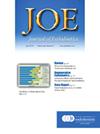下颌第二磨牙根部牙本质厚度的显微 CT 分析,跨越不同的牙根解剖变异:识别潜在危险区。
IF 3.5
2区 医学
Q1 DENTISTRY, ORAL SURGERY & MEDICINE
引用次数: 0
摘要
简介本研究旨在调查下颌第二磨牙(MSM)的放射状牙本质厚度,同时考虑牙根构造和髓室底层(PCF)形态的变化。此外,还确定了放射沟的类型和潜在危险区:使用显微 CT 扫描了 149 颗 MSM,并根据牙根融合和 PCF 形态将其分为四组:(1) 45 颗牙根融合,PCF 呈 C 形;(2) 45 颗牙根融合,PCF 呈非 C 形;(3) 14 颗牙根为单管;(4) 45 颗牙根分离。前两组又分为Ω形、U形和V形根状沟亚组。测量包括从根状沟或根分叉开始向根尖延伸 5 毫米的最小和平均牙本质厚度、外侧牙本质厚度与内侧牙本质厚度之比以及牙本质厚度的分布:结果:在C形和非C形牙髓底层类别中,Ω形和U形亚组在距放射槽起点2-5毫米处的最小内壁厚度明显薄于V形亚组(P < 0.05)。在最小内壁厚度、平均内壁厚度和平均外壁厚度方面,分根MSM的中侧根比非C形牙髓底层的牙本质明显薄(p < 0.05)。与其他三组相比,单根牙管的牙本质壁明显较厚:对于 MSM,尤其是在 C 形牙根中存在 Ω 形和 U 形凹槽时,以及在分离牙根的根嵴周围,必须小心谨慎。本文章由计算机程序翻译,如有差异,请以英文原文为准。
Micro–Computed Tomographic Analysis of Radicular Dentin Thickness in Mandibular Second Molars Across Diverse Anatomic Root Variations: Identifying Potential Danger Zones
Introduction
This study aimed to investigate radicular dentin thicknesses in mandibular second molars (MSMs), considering variations in root configuration and the morphology of the pulp chamber floor (PCF). The types of radicular grooves and potential danger zones were also identified.
Methods
A total of 149 MSMs were scanned with micro–computed tomographic imaging and classified into 4 groups according to root fusion and PCF morphology as follows: (1) 45 with fused roots and C-shaped PCFs, (2) 45 with fused roots and non–C-shaped PCFs, (3) 14 with a single canal, and (4) 45 with separated roots. The first 2 groups were subdivided into Ω-shaped, U-shaped, and V-shaped radicular groove subgroups. Measurements included minimum and mean dentin thickness from the start of the radicular groove or root bifurcation extending 5 mm apically, the ratio of outer to inner dentin thickness, and the distribution of dentin thickness.
Results
Ω-shaped and U-shaped subgroups showed significant thinner minimum inner wall thickness than V-shaped subgroups at 2–5 mm from the starting point of the radicular groove in both C-shaped and non–C-shaped pulp floor categories (P < .05). The mesial roots of separated rooted MSMs showed significant thinner dentin than a non–C-shaped floor regarding minimum and mean inner thickness and mean outer thickness (P < .05). Teeth with a single canal had significantly thicker walls compared with the other 3 groups.
Conclusions
In MSMs, caution must be exercised, especially in the presence of Ω-shaped and U-shaped grooves in C-shaped roots and around the root furcation of separated roots.
求助全文
通过发布文献求助,成功后即可免费获取论文全文。
去求助
来源期刊

Journal of endodontics
医学-牙科与口腔外科
CiteScore
8.80
自引率
9.50%
发文量
224
审稿时长
42 days
期刊介绍:
The Journal of Endodontics, the official journal of the American Association of Endodontists, publishes scientific articles, case reports and comparison studies evaluating materials and methods of pulp conservation and endodontic treatment. Endodontists and general dentists can learn about new concepts in root canal treatment and the latest advances in techniques and instrumentation in the one journal that helps them keep pace with rapid changes in this field.
 求助内容:
求助内容: 应助结果提醒方式:
应助结果提醒方式:


